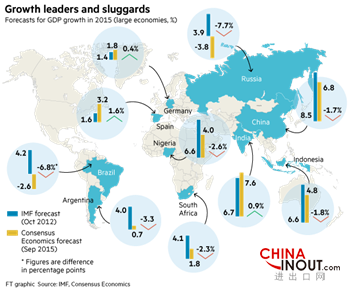世界经济似乎正处在一个岔路口。走其中一条路,意味着2016年世界经济状况可能要从平庸恶化为极糟;而走另一条,意味着自2008-09年金融危机以来的正常化进程将幸运地延续下去,全球经济将变得更平衡、更具可持续性。没人能确定世界将走哪条路;也没人知道政策力度是否大到足以影响结果。
毫无疑问,全世界锐利的目光都聚焦在这些风险和挑战上。恐惧在今夏人民币贬值后急剧上升,突显出人们对中国经济前景正迅速恶化以及其他昔日全球经济明星国家(如巴西、俄罗斯)衰退加深的担忧。全球股市刚刚经历了自2011年以来表现最糟的一个季度。
伴随金融市场的疲弱,资本回撤到了位于发达世界的“避险港”,大宗商品价格一落千丈,世界贸易增长仍停滞不前。由于中国占全球产出的16%、占全球预期增长的近3 0%,不久前还是世界经济可靠引擎的中国,如今被视为世界经济最大的薄弱之处。经合组织(OECD)称:“全球增长的主要风险在于中国超出预期的增长放缓。”
在花旗(Citi)等投资银行预测2016年出现全球经济衰退之际,各国官员积极希望避免像2008年衰退到来之前那样被打个措手不及。
国际货币基金组织(IMF)总裁克里斯蒂娜拉加德(Christine Lagarde)表示,由于“经济前景下行的风险已经增加——尤其是对于新兴市场经济体而言”,在此般“困难且复杂”的时刻,世界主要经济体亟需对策来应对问题。
英国央行(Bank of England)首席经济学家安迪霍尔丹(Andy Haldane)警告称,中国遭遇的麻烦表明“我们现在或许正在进入(全球危机)三部曲第三部分(即2015年起的‘新兴市场’危机)的初始阶段”。
继2008-09年美英经济体金融危机以及2011-12年欧元区危机后发生第三场危机,这种情景将源于2008年以来中国债务暴涨带来的危险。在家庭、企业勒紧腰带之前,2007年美国私人非金融债务达到了国内生产总值(GDP)的160%,英国的这一比例接近200%。根据国际清算银行(BIS)的数据,中国早已超过了上述两国的水平。
随着增长放缓(放缓速度也许远比中国官方统计数据显示的更快),偿付并维持这些债务的能力便成了问题。违约及巨额损失可能随之而来,引发金融部门脆弱性与破产的恶性循环,并导致信贷收紧,经济前景更加黯淡。鉴于中国经济的规模、它与其他国家的贸易及金融联系,世界其他国家可能无法忽视这样一场危机。
北京方面发出的含混不清的讯息以及今夏阻止股市泡沫破裂的努力失败,无法激发人们对于中国得天独厚、能够避免灾难的信心。
虽然存在这么多切实、貌似可信的担忧,但世界还未遭受一场新的经济风暴的冲击。虽然中国受到质疑的经济数据仍显示经济年增速为7%,但不可否认,中国正在从建筑与重机械业投资向消费和服务再平衡。世界其他许多大型经济体的境况和经济数据也远算不上很糟。
仍为世界最重要经济体的美国正在考虑启动10年来的首次加息。这反映了美国经济复苏已经成熟,实现就业增长的努力也已成功。美国失业率已降至历史正常水平。美联储(fed)主席珍妮特耶伦(Janet Yellen)对为何决定9月不加息的解释是全球经济不确定性增加。耶伦已明确表示,她认为美国经济前景强劲,负责确定利率的美国联邦公开市场委员会(FOMC)同僚也持同样看法。
“当前,包括我自己在内的多数联邦公开市场委员会成员预计,达到(充分就业和稳定通胀的)条件后,我们可能需要在今年晚些时候迈出提高联邦基金利率的第一步,随后渐进式收紧,”耶伦9月表示。
在欧洲,许多经济指标看起来比2011年欧元区危机爆发以来的任何时候都更加积极。希腊今年已表现出它不再有能力让欧元区其他国家经济脱轨,而随着全球大宗商品价格下跌,消费者正在享受少有的净收入增加。
货币、财政政策随时待命,准备应对全球经济增长放缓前景,未来几个月还可能出台进一步货币政策刺激。
作为石油与金属的大型进口国,中国从大宗商品价格下跌中获益,同样受益的还有印度——世界增长最快的大型经济体。许多治理较好的大宗商品出口国受益于货币贬值,在没有显著提高通胀率的情况下抵消了降价对国内造成的冲击。
凯投宏观(Capital Economics)分析师朱利安瀠≧湽(Julian Jessop)认为,市场对今夏事件的震惊反应太过突然和过度:“因此,我们认为,主流观点在追赶已经存在多年的趋势,而不是说这种动荡是一种新的威胁。”
如果真是如此,世界是在继续以约为过去30年平均水平的速度增长(其中有的国家做得好一些,有的差一些),而非正进入全球金融危机的第三阶段,换句话说,是常态,而非非常时期。
对中国而言,如果这种务实的观点站得住脚的话,那么中国当局在推动经济由投资转向消费再平衡的过程中会犯错,但也会取得进展。
裕信银行(UniCredit)首席经济学家埃里克尼尔森(Erik Nielsen)说,尽管面临许多选项,但2016年的世界不必选择一条极端道路。
“我们经济学家喜欢预测未来道路是一片坦途,而一惊一乍者和危言耸听者喜欢预测崩溃即将来临,”他说。
“也许保险的预测介于两者之间:未来道路崎岖不平,但情况在合理可控范围内。”(中国进出口网)

The world economy appears to be at a fork in the road. On one path, 2016 appears likely to witness a deterioration from the mediocre to the miserable; on the other is a happy continuation of the normalisation from the 2008-09 financial crisis, with a more balanced and sustainable global economy. No one is sure which path the world will follow; nor whether policy is sufficiently strong to influence the outcome.
There is little doubt that the eyes of the world are sharply focused on the risks and challenges. Fears rose precipitously in the summer after China devalued its currency, highlighting concerns that the country’s economic prospects are deteriorating rapidly and recessions deepened in other former stars of the global economy such as Brazil and Russia. Global equity markets have just endured their worst quarter since 2011.
Alongside weak financial markets, capital has retreated towards havens in the developed world, commodity prices have plummeted and world trade growth remains stalled. China, not long ago the reliable engine of the world economy, is now seen as its greatest vulnerability, representing, as it does, 16 per cent of world output and almost 30 per cent of expected growth. “The key risk to global growth is a larger-than-expected slowdown in China,” according to the Organisation for Economic Co-operation and Development.
With some investment banks such as Citi forecasting a global recession in 2016, officials are keen not to be caught napping as they were before the 2008 downturn.
Christine Lagarde, head of the IMF, says policies to address problems among the world’s leading economies are urgently needed at a“difficult and complex” time, since “downside risks to the outlook have increased, particularly for emerging market economies”.
Andy Haldane, chief economist of the Bank of England, warns that the troubles in China are signs that “we may now be entering the early stages of part three of the [global crisis] trilogy, the ‘emerging market’ crisis of 2015 onwards”.
A third crisis scenario — following that in the US and UK economies in 2008-09 and the eurozone in 2011-12 — would stem from dangers posed by the rise in Chinese debt since 2008. Private, non-financial debt reached 160 per cent of gross domestic product in the US in 2007 and almost 200 per cent in the UK before households and companies tightened their belts. China has already surpassed these levels, according to data from the Bank for International Settlements.
With growth slowing, perhaps far more rapidly than official Chinese statistics show, the ability to service and sustain such debt is in question. Defaults and huge losses could follow, sparking a vicious circle of fragility and bankruptcy in the financial sector, a squeeze on credit and yet weaker economic prospects. The rest of the world would not be able to ignore such a crisis, given China’s size, trade links and financial connections with other countries.
Beijing’s mixed messages and failed attempts to prevent its stock market bubble bursting over the summer have not inspired confidence that it is uniquely placed to avoid disaster.
But for all these genuine and plausible fears, the world is not yet being buffeted by another economic storm. Despite contested Chinese economic statistics showing growth still at an annual rate of 7 per cent, there is undeniable rebalancing under way in China from construction and heavy machinery investment towards consumption and services. In many of the other large world economies, the picture and the economic data are far from disastrous.
Still the world’s most important economy, the US is contemplating raising interest rates for the first time in a decade. This reflects the maturity of its economic recovery and its success in generating employment growth. The unemployment rate has fallen to historically normal levels. Janet Yellen, Federal Reserve chair, explained the decision not to raise rates in September as reflecting increased uncertainty in the global economy. Ms Yellen has made it clear that she sees strong prospects when she looks at the US, as do her colleagues on the Federal Open Market Committee, which sets interest rates.
“Most FOMC participants, including myself, currently anticipate that achieving these conditions [of maximum employment and stable inflation] will likely entail an initial increase in the federal funds rate later this year, followed by a gradual pace of tightening,” Ms Yellen said in September.
In Europe, many economic indicators are looking more positive than at any time since the eurozone crisis started in 2011. Greece showed this year that it no longer has the power to derail the rest of the single currency area and consumers are enjoying a rare increase in their net incomes following the decline in commodity prices across the world.
Monetary and fiscal policy is standing by, ready to react to slower global growth prospects, with further monetary stimulus likely in coming months.
As a big oil and metals importer, China gains from the fall in commodity prices, as does India — the world’s fastest growing big economy. Many of the better managed commodity-exporting economies have benefited from currency depreciation, offsetting the domestic hit from lower prices without raising inflation significantly.
Julian Jessop of analysts Capital Economics thinks that the shocked market reaction to the events of the summer has been far too sudden and excessive: “The upshot is that rather than the turmoil being a new threat, we think that the consensus is playing catch-up with trends in place for several years.”
If true, rather than the world entering a third leg of a global financial crisis, it is more a continuation of global growth at roughly the average level of the past 30 years, with some countries doing better than others: normality rather than extraordinary times.
As for China, if this pragmatic view holds true, the authorities will make errors but also progress in rebalancing the economy from investment towards consumption.
The world in 2016 does not need to take an extreme path, says Erik Nielsen, chief economist at UniCredit — though there are many options available.
“We economists love to forecast smooth paths, while drama queens and headline grabbers love to predict imminent collapse,” he says.
“Maybe the safe forecast is one in between the two: bumpy, but reasonably well managed.”











